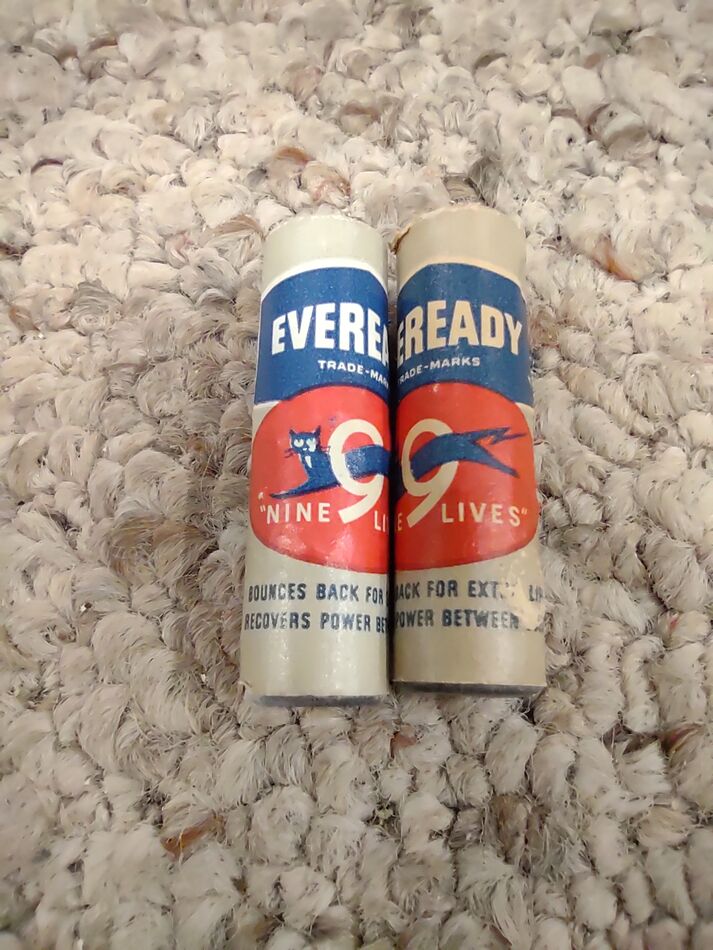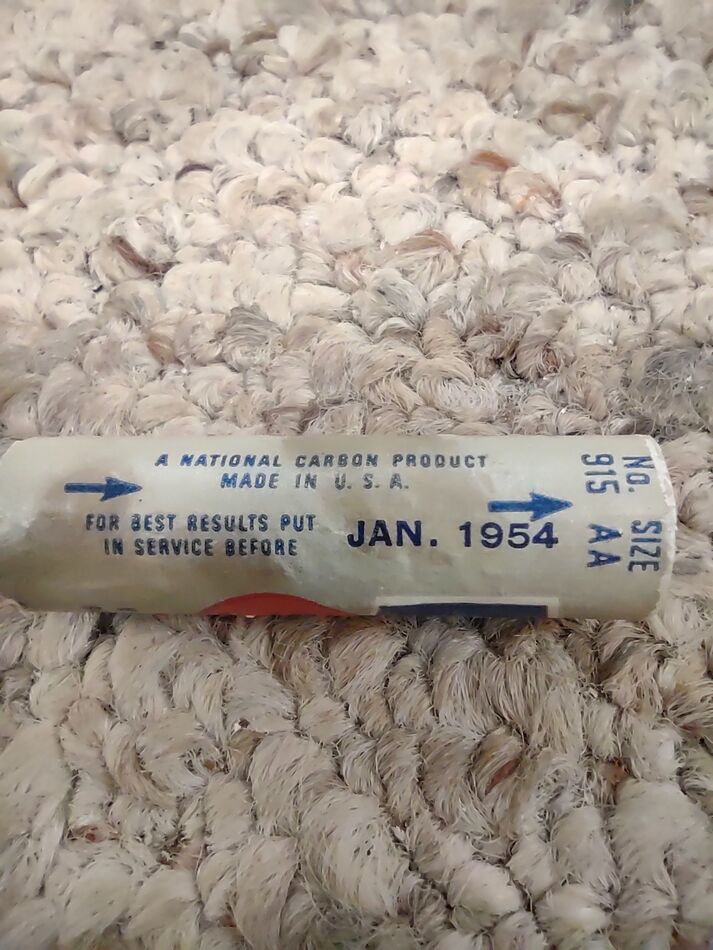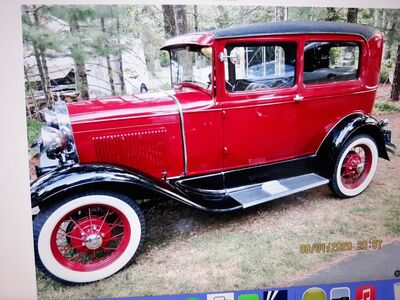Eveready 9 lives
May 1, 2023 11:41:20 #
JR69
Loc: Wolverine Michigan
Bought a box lot of old camera equipment at an auction a week or so ago, box, bellows Polaroid ect. Amongst the equipment, I found a Whitehouse Beacon-II 127 camera, circa 1947-1955. . .
Along with the camera a Beacon Flash synchronizer was there. Playing with the flash I found these batteries still in the unit..... VERY very little leakage and the contacts were in great shape !!
I put a meter on the AA's expecting them to be completely drained and found them to still have .7 and .8 V Dead no doubt but I expected them to be at zero. None the less I was amazed that the batteries didn't leak massively and corrode the whole unit.
Along with the camera a Beacon Flash synchronizer was there. Playing with the flash I found these batteries still in the unit..... VERY very little leakage and the contacts were in great shape !!
I put a meter on the AA's expecting them to be completely drained and found them to still have .7 and .8 V Dead no doubt but I expected them to be at zero. None the less I was amazed that the batteries didn't leak massively and corrode the whole unit.
May 1, 2023 11:46:53 #
Wow, I'm surprised they didn't fill the battery compartment with crud!
(Most likely carbon-zinc construction.)
(Most likely carbon-zinc construction.)
May 1, 2023 12:22:22 #
Dear JR69,
Another wow that the batteries still have juice ,as they say for SOME things "they don't make them like they used to"
I also wonder why these lasted, hope the Hoggers come up with answers if there are any answers !
Another wow that the batteries still have juice ,as they say for SOME things "they don't make them like they used to"
I also wonder why these lasted, hope the Hoggers come up with answers if there are any answers !
May 1, 2023 12:33:31 #
Dear JR69,
I forgot to say in my reply to you,"a big thank "you", for buying those items at auction, hope it was fun and maybe you gave some new life to some items ! ( except the batteries). smile!
I forgot to say in my reply to you,"a big thank "you", for buying those items at auction, hope it was fun and maybe you gave some new life to some items ! ( except the batteries). smile!
May 1, 2023 12:53:16 #
COOL! Nostalgia! I miss the original "cat" logo that appeared on all Eveready products- all the flashlight and "Photoflash" sizes, the big dry cells, with screws terminals, the 67.5 and 90 Volt Radio B Batteries, and the 2 225 Volt Dry Cells that were used, back in the day, in my Graflex SR Strobes.
I also miss the Cats' Paw logo that used to be a die pad at shoe repair shops.
We've always had a family CAT!
I like when corporations retain the original logos rather than modernize them.
I also miss the Cats' Paw logo that used to be a die pad at shoe repair shops.
We've always had a family CAT!
I like when corporations retain the original logos rather than modernize them.



May 2, 2023 07:20:39 #
I found old batteries don't leak as often as new ones. It makes me suspect that due to some new regulation they have to change the chemistry in the batteries that makes them more likely to leak.
May 2, 2023 08:26:48 #
May 2, 2023 11:22:02 #
My dad had the "cats paw" logo everywhere in his shoe repair shop. Landis and Singer equipment where the standards then.
May 2, 2023 19:58:50 #
JR69 wrote:
Bought a box lot of old camera equipment at an auc... (show quote)
Those batteries are older than I am! It sounds like they were used only gently before the flash was stored.
Most non-rechargeable batteries leak when completely depleted, especially if depleted quickly, which causes heat expansion. Today's alkaline batteries are designed to leak so they don't swell and get stuck in tubular battery compartments like flashlights.
I have a Sennheiser wireless mic system. The transmitter drains a pair of AAs in about five hours, and they will leak if I don't remove them immediately after use and throw them away. I've cleaned contacts in that thing several times when my wife and kids used it for a project and forgot to toss the batteries.
Battery compartment contacts can be cleaned most effectively with a 1:1* solution of vinegar applied to a rough cloth (*2.5% acetic acid when diluted 1:1 with water). After wiping with diluted vinegar, quickly use another cloth moistened with distilled water to remove the residue. Then take it outdoors and blast it with DeoxIT D5S-6-LMH Contact Cleaner Spray. That's the stuff electronics techs use to clean dirty circuit boards, switches, potentiometers, and connectors. It removes oxidation and leaves a conductive, protective film. Find it on Amazon. It's worth its high price. Just don't breathe it.
I love that old 9 Lives trademark. Union Carbide made those old carbon-zinc cells. Back in the 1950s, you only needed a jolt of power when the flashbulb had to be lit. A lot of flashguns were 'BC' — battery-capacitor powered. Inserting a bulb would charge a capacitor. Tripping the shutter would discharge the capacitor into the flashbulb, burning the foil inside its oxygen atmosphere. It was rudimentary, but it worked. I still have a couple old cameras with flashguns that worked like that.
May 2, 2023 22:20:50 #
burkphoto wrote:
Those batteries are older than I am! It sounds lik... (show quote)
My BC Packs worked with 22.5 Volt "hearing aid" batteries. I had flashguns for flash bulbs made by Kalart, Heiland, Mendelson, and Graflex.
May 3, 2023 10:15:01 #
E.L.. Shapiro wrote:
My BC Packs worked with 22.5 Volt "hearing aid" batteries. I had flashguns for flash bulbs made by Kalart, Heiland, Mendelson, and Graflex.
In the beginning (of photography) we paid for "one-time use" image storage (film) and artificial light (flashbulbs). My parents complained about my film-and-flashbulbs addiction when I was a little kid.
I was so happy to get away from flashbulbs. They were expensive! I had a similar feeling when moving from film to digital!
May 3, 2023 11:36:43 #
Dear burkphoto,
Thanks for your reply, you really seem to know what you are talking about. Good answer !
Thanks for your reply, you really seem to know what you are talking about. Good answer !
May 3, 2023 11:41:01 #
mwsilvers
Loc: Central New Jersey
JR69 wrote:
Bought a box lot of old camera equipment at an auc... (show quote)
They are in remarkably good shape. Those batteries are almost 70 years old. I'm surprised they didn't leak decades ago.
With regard to very old battery power retention, a friend gave me a Christmas tie around 25 years ago with a tiny built-in battery powered button that played a Christmas song when pushed. I only wear that tie once or twice at Christmastime each year, and pushed the button every year at least once to see if the song still played. The last time I tried it was 20 years after I received the tie. The song was no longer recognizable and only played a few slow notes, but there were still enough power to get sound out of it.
I was amazed that the tiny non-replaceable coin battery in that very tiny inexpensive device contained in the tie still had some residual power left after 20 years.
May 3, 2023 13:08:35 #
burkphoto wrote:
In the beginning (of photography) we paid for "one-time use" image storage (film) and artificial light (flashbulbs). My parents complained about my film-and-flashbulbs addiction when I was a little kid.
I was so happy to get away from flashbulbs. They were expensive! I had a similar feeling when moving from film to digital!
I was so happy to get away from flashbulbs. They were expensive! I had a similar feeling when moving from film to digital!
My parents also complained about my flashbulb issue. It was not the expense because we had a deal about my doing various chores to earn the money. It was my propensity for screwing Press-50 flashlamps into the bathroom fixture so the first family member to brush their teeth in the morning would get a surprise. My goodness- the language they would blurt out! Then they complained about seeing spots before their eyes until lunchtime.
Those big lamps had a fuse built into the base that allowed them to be safely used with 117Volt household line voltage. They were long-peek and had an enormous lumen-second output. Besides my pranks, later on in life, I used those big bulbs to photograph large groups indoors, and outdoors they provide great flash fill at longer distances. I recall shooting a group of 100 choir and orchestra members 35 feet away at f/16 on ASA 400 film. Back in those days, my portable strobes outputted a maximum of 200 watt.second so I would bring back the flashbulbs for certain jobs. Another method was to temporarily replace all the incandescent lightbulbs in large industrial sites with Press 50 or Press -50 flash lamps, set the shutter at "B", open the shutter, flip the light switch, "FLASH/BANG!" close the shutter, and an entire factory was perfectly and (looked) naturally lighted. We had a formula to calculate the aperture settings.
For anyone who is interested, these lamps are still available - here's a link https://flashbulbs.com/
This can save money if anyone was contemplating the purchase of a 4800-watt.second electron flas system!


May 3, 2023 15:51:46 #
E.L.. Shapiro wrote:
My parents also complained about my flashbulb issu... (show quote)
$18 each for Press 50.
$85/dozen for Press 25B.
Not too bad, considering the effects of inflation over the last 60+ years…
If you want to reply, then register here. Registration is free and your account is created instantly, so you can post right away.







